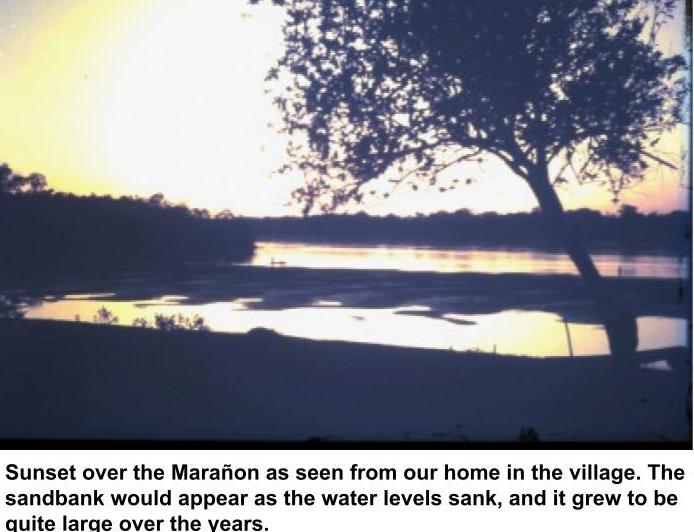Chapter 32: Settling in Tigre Playa
Establishing a home and a base for future work in the village Tigre Playa
AS TOLD BY GRO AGERSTEN
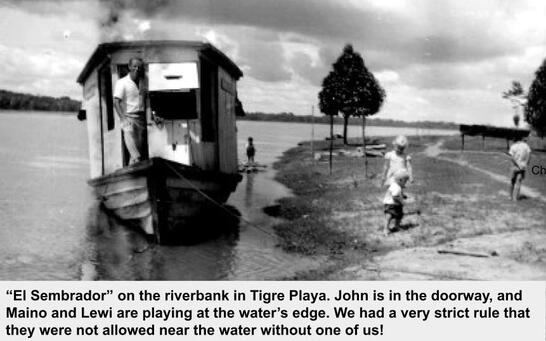
We were very excited as we approached the village Tigre Playa again on Jan. 1st, 1970 after spending Christmas in Yurimaguas. We were happy and grateful we had been led to this village that would be our home and base for the ministry in the region. As we docked and tied up the boat in front of the hut we had purchased, quite a few villagers came to meet us although many were still working on their fields at this time of day.
Before we left for Yurimaguas we had hired some people to repair the two huts, including laying new palm roofs. We could see that the roof on the main hut was not complete yet, and we were a bit disappointed since we had looked forward to moving out of the narrow, wobbly boat after living in it for three months. Fortunately, the smaller kitchen hut had a brand new palm roof, so we would be able to use it right away. It was situated behind the main hut and there was a short bridge between them. Both huts were on stilts as is usual in the jungle and had walls and floors of bamboo and palm trunks that were cut open and unfolded. Everything was tied together with vines without any nails. A couple of the walls just went up halfway, and the resulting openings served as windows. There was no door, but just a small gate into the house from steps leading up to the front of the main building. It didn’t stop people from coming in, but it did keep out the neighborhood dogs.
Before we left for Yurimaguas we had hired some people to repair the two huts, including laying new palm roofs. We could see that the roof on the main hut was not complete yet, and we were a bit disappointed since we had looked forward to moving out of the narrow, wobbly boat after living in it for three months. Fortunately, the smaller kitchen hut had a brand new palm roof, so we would be able to use it right away. It was situated behind the main hut and there was a short bridge between them. Both huts were on stilts as is usual in the jungle and had walls and floors of bamboo and palm trunks that were cut open and unfolded. Everything was tied together with vines without any nails. A couple of the walls just went up halfway, and the resulting openings served as windows. There was no door, but just a small gate into the house from steps leading up to the front of the main building. It didn’t stop people from coming in, but it did keep out the neighborhood dogs.
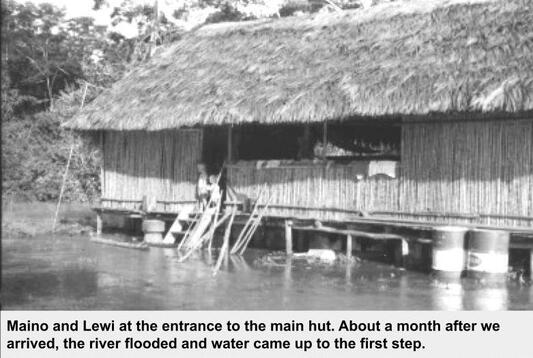
We moved into the kitchen hut with our table and some chairs we had in the boat. We laid our mattresses on the floor on top of some heavy plastic sheets, then hung the mosquito netting over that. Every morning we would put the “beds” away for the day. Even though it was cramped in the small hut, we were glad to sleep in a “house” again and have solid ground under us. However, that first night we woke up to a racket under the kitchen floor. The neighborhood pigs had gotten used to sleeping on the ground under the hut and there was a lot of scuffling, oinking, and squealing right under us. We got up several times to chase them away, but as soon as we lay down again, they would come back. After a few nights of interrupted sleep, John had an idea. Just before going to bed that evening, we boiled a big kettle of water. We hadn't slept long before we were awakened by the pigs again. John got up, got the kettle, and poured the water through the cracks in the palm floor onto the pigs. There was quite a commotion and noise as the pigs ran out of there, and that was the last time they laid down under our hut!
We did have other small animal visitors; the forest rats were particularly bold. They did not usually wake us up, but if we were awake, we could often hear them around the mattresses. We were thankful for the mosquito nets that not only kept the mosquitos out but also other insects and small critters such as bats and rats. All food items had to be carefully stored away in barrels, cans, and glass jars, and we learned quickly that it was important to clean away any bits of food and crumbs from all surfaces to avoid an invasion of ants.
We did have other small animal visitors; the forest rats were particularly bold. They did not usually wake us up, but if we were awake, we could often hear them around the mattresses. We were thankful for the mosquito nets that not only kept the mosquitos out but also other insects and small critters such as bats and rats. All food items had to be carefully stored away in barrels, cans, and glass jars, and we learned quickly that it was important to clean away any bits of food and crumbs from all surfaces to avoid an invasion of ants.
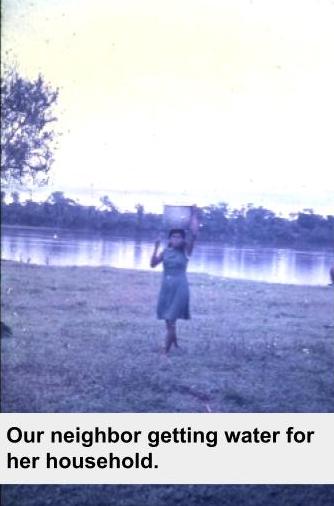
Moving in and practical tasks
The day after arriving in Tigre Playa, some young boys helped John move the refrigerator and the cooking stove out of the boat and into the house. He also brought in a small table with shelves and a mirror that hung above it. There we kept the washbowl and toiletries. John started making me a kitchen counter right away with shelves out of materials from palm trees bound together with vines. The countertop was a new tin plate. It was simple but functional! At night, we were thankful for the Petromax lamp that gave us good light. It used paraffin, just like the stove and refrigerator.
We had to get water from the river. The Marañon river water is brown since the strong current stirs up the mud and sediments from the riverbed. This is particularly true during the rainy season when the river runs high and fast. We would bring in water in the afternoon and pour it into some clean barrels. During the night, the sediment would settle to the bottom. We would then boil any water we would be using for drinking. It was a lot of work to get enough usable water. At least when the water was high, it was not so far to carry, but when it got low, the riverbank was further from the house and the bank would be muddy.
We bathed in the river each evening before it got dark and the mosquitos arrived. It always got dark around 6 - 6:30 pm year-round. We were usually sweaty and hot, so it was refreshing to bathe and change clothes each evening. We were early to bed and up with the sun just like the rest of the villagers.
While we were making shelves and doing other things to make our lives as practical as possible in this primitive environment, the workers we had hired in the village were laying the roof on the main building. They finished after a few days, and John left with the boat for Borja to bring back the rest of our things. We had been able to store them in a house in Borja when we started our journey in the “El Sembrador” from there about three months ago. Happily, he found everything just as we had left it. When he returned to Tigre Playa with everything we had lots of help to carry and many curious observers as well. They helped carry in our beds, some simple furniture, a couple of big wooden boxes, and our travel trunk that would serve as a coffee table during our stay in the bamboo hut. The beds and the furniture had been taken apart and had to be reassembled, something that our young helpers found very fascinating.
The main hut had a good size room in the center. The entrance gate was in the middle front of this room, and opposite it in the back was the little bridge to the kitchen hut. There was a bedroom on either side: a larger one where we placed our double bed and a dresser, and a smaller one that would be Maino and Lewi’s room. We had not brought their beds because they could not be disassembled and packed flat, and there was no room for them in the moving load. John built them beds out of palm tree materials, and also shelves for clothes. Mattresses were put on the beds and finally, the mosquito netting was hung and tightly tucked under the mattresses to protect them from mosquitos and other crawling things. They seemed quite happy with their new beds.
Once we were pretty well settled, John made several sawhorses that we could lay planks over. These we used as benches when our living room needed to be turned into a church for services. We did not have much living room furniture, only a simple bookshelf we had with us from Norway, two camping chairs, and the travel trunk serving as a coffee table. Maino and Lewi also had a small camping chair each. This made it easy to change the function of the room. When not in use as benches for church services, the sawhorses and planks were stored on the ground under the palm floor.
The day after arriving in Tigre Playa, some young boys helped John move the refrigerator and the cooking stove out of the boat and into the house. He also brought in a small table with shelves and a mirror that hung above it. There we kept the washbowl and toiletries. John started making me a kitchen counter right away with shelves out of materials from palm trees bound together with vines. The countertop was a new tin plate. It was simple but functional! At night, we were thankful for the Petromax lamp that gave us good light. It used paraffin, just like the stove and refrigerator.
We had to get water from the river. The Marañon river water is brown since the strong current stirs up the mud and sediments from the riverbed. This is particularly true during the rainy season when the river runs high and fast. We would bring in water in the afternoon and pour it into some clean barrels. During the night, the sediment would settle to the bottom. We would then boil any water we would be using for drinking. It was a lot of work to get enough usable water. At least when the water was high, it was not so far to carry, but when it got low, the riverbank was further from the house and the bank would be muddy.
We bathed in the river each evening before it got dark and the mosquitos arrived. It always got dark around 6 - 6:30 pm year-round. We were usually sweaty and hot, so it was refreshing to bathe and change clothes each evening. We were early to bed and up with the sun just like the rest of the villagers.
While we were making shelves and doing other things to make our lives as practical as possible in this primitive environment, the workers we had hired in the village were laying the roof on the main building. They finished after a few days, and John left with the boat for Borja to bring back the rest of our things. We had been able to store them in a house in Borja when we started our journey in the “El Sembrador” from there about three months ago. Happily, he found everything just as we had left it. When he returned to Tigre Playa with everything we had lots of help to carry and many curious observers as well. They helped carry in our beds, some simple furniture, a couple of big wooden boxes, and our travel trunk that would serve as a coffee table during our stay in the bamboo hut. The beds and the furniture had been taken apart and had to be reassembled, something that our young helpers found very fascinating.
The main hut had a good size room in the center. The entrance gate was in the middle front of this room, and opposite it in the back was the little bridge to the kitchen hut. There was a bedroom on either side: a larger one where we placed our double bed and a dresser, and a smaller one that would be Maino and Lewi’s room. We had not brought their beds because they could not be disassembled and packed flat, and there was no room for them in the moving load. John built them beds out of palm tree materials, and also shelves for clothes. Mattresses were put on the beds and finally, the mosquito netting was hung and tightly tucked under the mattresses to protect them from mosquitos and other crawling things. They seemed quite happy with their new beds.
Once we were pretty well settled, John made several sawhorses that we could lay planks over. These we used as benches when our living room needed to be turned into a church for services. We did not have much living room furniture, only a simple bookshelf we had with us from Norway, two camping chairs, and the travel trunk serving as a coffee table. Maino and Lewi also had a small camping chair each. This made it easy to change the function of the room. When not in use as benches for church services, the sawhorses and planks were stored on the ground under the palm floor.
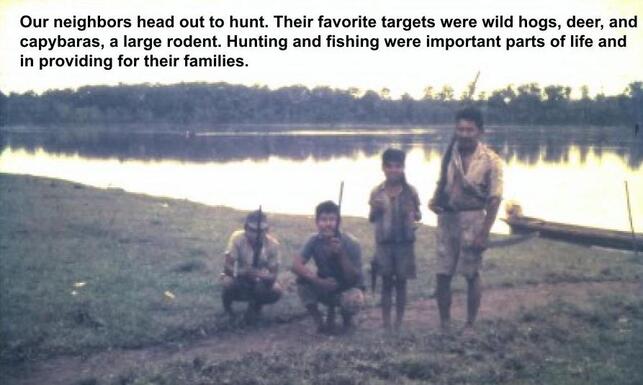
We invite the villagers to services at our house
We went and visited all the homes in the village the week before our first Sunday service. In a couple of homes, the people were dismissive and would barely speak to us, but overall we were almost surprised at how welcoming and friendly the people were toward us. Here, as in most of the villages along the Marañon, people were predominantly Spanish speakers. They were mostly descendants of people who had moved into the jungle from the mountains either to work in the rubber industry or just looking for land to farm. We discovered that many of the older generations did not speak Spanish well. They spoke a Quechua dialect that is used in the mountainous jungle areas in the northeastern part of Peru. When we arrived, the state had established Spanish-speaking schools in many of the villages, so the next generation often spoke both. In contrast, the younger generations only spoke Spanish fluently with the exception of a few Quechua words they had learned from their grandparents. This was to our advantage since we had been working with and practicing our Spanish for three years now.
Not many people came to that first service, but as the weeks passed, our living room filled up with children and adults during the services. A few young people had accepted Jesus during our first visit last fall, and now several others joined them in the faith. The teaching, the songs, and the accordion music were something new and interesting for both young and old.
We went and visited all the homes in the village the week before our first Sunday service. In a couple of homes, the people were dismissive and would barely speak to us, but overall we were almost surprised at how welcoming and friendly the people were toward us. Here, as in most of the villages along the Marañon, people were predominantly Spanish speakers. They were mostly descendants of people who had moved into the jungle from the mountains either to work in the rubber industry or just looking for land to farm. We discovered that many of the older generations did not speak Spanish well. They spoke a Quechua dialect that is used in the mountainous jungle areas in the northeastern part of Peru. When we arrived, the state had established Spanish-speaking schools in many of the villages, so the next generation often spoke both. In contrast, the younger generations only spoke Spanish fluently with the exception of a few Quechua words they had learned from their grandparents. This was to our advantage since we had been working with and practicing our Spanish for three years now.
Not many people came to that first service, but as the weeks passed, our living room filled up with children and adults during the services. A few young people had accepted Jesus during our first visit last fall, and now several others joined them in the faith. The teaching, the songs, and the accordion music were something new and interesting for both young and old.
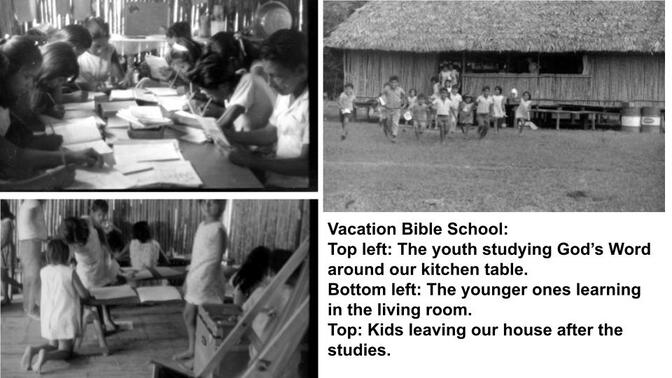
Ministering to both body and spirit.
In a letter home, I summed up some of our new experiences:
“At this time of the year, the village children are on a three-month summer vacation from school. On February 2nd we started a two-week Bible School for them. Every afternoon from 2 pm to 4:30 pm, our house is full of children and young people who are excited to be learning. We have them in two groups; I am in the living room with the 7 to 13-year-olds, while John is in the kitchen hut with the 14 to 20-year-olds. Since there has been a school here for several years, most of them can read although it is often slow going. Of the adult population, very few can read and illiteracy is particularly common among the women. I’m actually starting lessons with one of the women who wants to be able to read the Bible.
In a letter home, I summed up some of our new experiences:
“At this time of the year, the village children are on a three-month summer vacation from school. On February 2nd we started a two-week Bible School for them. Every afternoon from 2 pm to 4:30 pm, our house is full of children and young people who are excited to be learning. We have them in two groups; I am in the living room with the 7 to 13-year-olds, while John is in the kitchen hut with the 14 to 20-year-olds. Since there has been a school here for several years, most of them can read although it is often slow going. Of the adult population, very few can read and illiteracy is particularly common among the women. I’m actually starting lessons with one of the women who wants to be able to read the Bible.
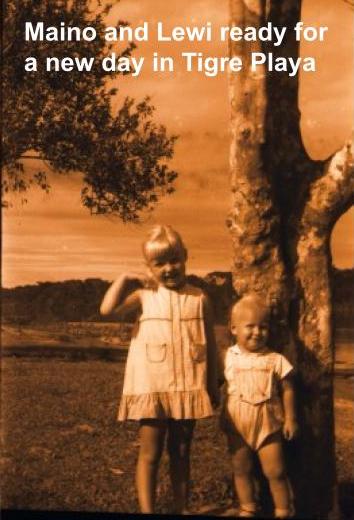
There are also a lot of physical needs around us. Every day people come to us for help and medications for a variety of illnesses. John takes care of the majority of this work. Fortunately, we are staying healthy ourselves. The children are doing great and keep busy all day. Maino is very excited about the “school” and all the children who come each afternoon. She walks around singing all day long and talking our ears off. Lewi runs around right outside and pretends he is driving a boat with an outboard motor.
I’d better end this letter now. It is late, the paraffin lamp is out, and I am writing in the light of a couple of candles. The mosquitos are biting, and I need to get under the mosquito netting. This letter will be sent with a boat that is stopping at the village in the morning on its way to Iquitos. They will post our letters there.”
These first months in Tigre Playa became a pioneering time in many ways. We had a lot to learn about life and the people of the jungle. It was also a very busy time. It felt like things were in place, just waiting for us to start the ministry. There were so many needs in so many areas, more than we had been able to imagine before we arrived, but we could feel the prayers of family and friends and the hand of the Lord with us every step of the way.
I’d better end this letter now. It is late, the paraffin lamp is out, and I am writing in the light of a couple of candles. The mosquitos are biting, and I need to get under the mosquito netting. This letter will be sent with a boat that is stopping at the village in the morning on its way to Iquitos. They will post our letters there.”
These first months in Tigre Playa became a pioneering time in many ways. We had a lot to learn about life and the people of the jungle. It was also a very busy time. It felt like things were in place, just waiting for us to start the ministry. There were so many needs in so many areas, more than we had been able to imagine before we arrived, but we could feel the prayers of family and friends and the hand of the Lord with us every step of the way.
